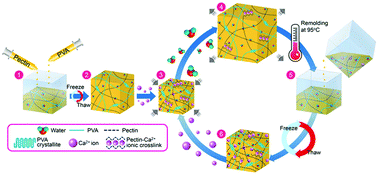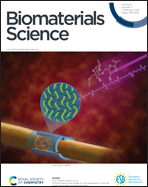Tough hydrogel module towards an implantable remote and controlled release device†
Abstract
On-demand controllable drug delivery systems enable the administration of precise dosages and thus have the potential to improve overall healthcare. In this work, a tough physical hydrogel is developed and studied for triggered burst release. Semicrystalline poly (vinyl alcohol) (PVA) is combined with ionic pectin (CaP) to form an interpenetrating network (PVA-CaP). The synergistic combination of crosslinking mechanisms resulted in a threefold improvement in tensile modulus and fracture energy over pristine PVA. As a result of the physical network, crosslink dissociation could be induced by heating. This trait is used as a trigger for burst release of a payload in PVA-CaP flexible substrates. Highly localized and on-demand burst release can be effectively achieved through the inclusion of electronic devices. Cell adhesion and viability tests show that the addition of pectin remarkably improves cell attachment ability and provides a favourable environment for cell proliferation. Implantation tests finally show the suitability of the material for implantation and its ability to conform with natural tissue. Such a system is envisioned for use as an implantable remote and controlled release device.



 Please wait while we load your content...
Please wait while we load your content...